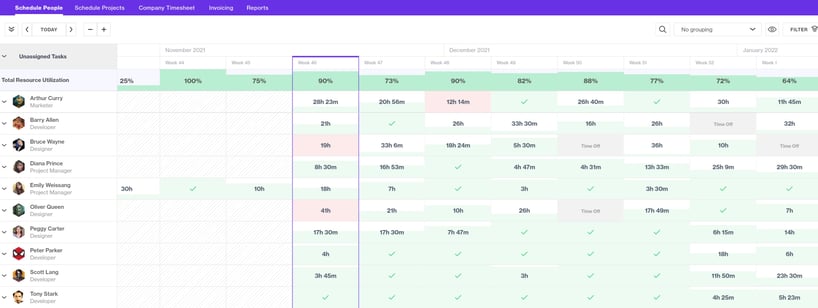How to Handle Ad Hoc Projects (When You Really Don't Have Time)

There are only so many hours in the day - and for Project Managers, most of those hours are likely already accounted for. That's why it can be so disruptive and pressuring when ad hoc projects or requests get pushed onto your team. You're suddenly in a position where you have to make time open up out of nowhere.
And because they don't come through the official channels, ad hoc projects are vulnerable to missing those important parts of the planning process that protect projects from going awry. What sounds like a fairly straightforward project at first can contain hidden complexities. But these might get missed if the project is accelerated past the initial checks and procedures that would otherwise be standard practice. This is particularly a risk when time is scarce.
It certainly isn't an ideal set of circumstances. But, as a Project Manager, it's inevitable that you will face ad hoc projects occasionally. Let's look at some things you can do to rein in the chaos and make a success out of a challenging situation.
- What are Ad Hoc Projects?
- How to Tackle an Ad Hoc Project When Time is Limited
- The Benefits of Tracking Ad Hoc Projects
- How Tech Can Help You Handle Ad Hoc Projects
What are Ad Hoc Projects?
Any unscheduled, unexpected project that ends up on your desk can be thought of as an ad hoc project. Ad hoc projects often arise reactively, as the result of a particular issue or problem that has been identified. And for this reason it might be even more time-pressured than a regular, scheduled project.
Examples of an ad hoc project might include a PR or customer education campaign responding to an issue that has suddenly come to light in the media, or a sudden need for IT systems improvement - perhaps in response to a security threat that had been overlooked.
Because you don't know when an ad hoc project is going to crop up and what the nature and scope of the work might be, preparing ahead of time is extremely difficult.
How to Tackle an Ad Hoc Project When Time is Limited
Though ad hoc projects come out of the blue and you've got limited time to play with, there's no reason to abandon procedural thinking in order to get them done. The key is to find a methodical approach that you can action quickly, supported by the right tools.
1. Determine the real urgency of the request
As previously mentioned, ad hoc project work often arises as the result of a problem that needs to be fixed, right now. Whoever brought you the ad hoc request would no doubt like for their work to take priority - but project management is a perpetual balancing act.
Your time is precious and everything else that your team is working on will not simply disappear just to accommodate this request. You need to be realistic and determine a delivery timeframe, but you can only do this once you have understood just how urgent the work is.
Is there a specific deadline that needs to be hit? Is it just “as soon as possible”? What risks would be associated with pushing this work back? All of these considerations will help you determine the objective urgency of the work. And if the work can be pushed back to fit a more realistic timeframe, it should be.
2. Assess the risks
Even if you are extremely short on time, it is not worth skipping risk assessment. But, in order to keep the timeframe for your risk assessment manageable, you will have to be realistic. The assessment might not be comprehensive, but it should certainly capture the main risks that could arise from undertaking the project. Prioritize contingency planning for these primary risks.
Learn more about how to create contingency plans and assess risk using an Impact-Probability Matrix.
3. Consider your resource capacity
Amidst the regular project work they have going on, your team might not have room for the ad hoc project without something else taking a hit. It might be that the ad hoc project has to take priority - but, in that case, you should try to assess whether this will result in delays on a different project.
It can all get very complicated very quickly, unless you have a clear method of visualizing your resourcing. A resource heatmap, such as the one below by Forecast, can help you quickly determine how much capacity your team has for additional work.
A dynamic resource heatmap will help you quickly visualize your team's capacity
If possible, you want to make sure that only some of your team are allocated to the ad hoc project. It’s ideal if most of your team can keep working towards their regular, scheduled project work to avoid setbacks as far as possible.
4. Don't skimp on planning...but let automation lend a hand
Once you’ve figured out how urgent the work is, and your resource availability, you can estimate how long the work is going to take. Depending on how complicated the project is, producing a work breakdown structure can help you make an accurate assessment of the time it will take to complete the project.
Creating the work breakdown structure might be time-consuming, so if you're short on time, the key is to get the most value out of this activity. If you break down the work in a project management tool like Forecast - scoping out the work from top-level phases, down to individual tasks - you can leverage the power of automation to turn your WBS into a fully mapped out Gantt Chart at the click of a button.
5. Complete (and track) the work
If work comes in off the cuff, it might be tempting just to treat it in the same casual manner - fit it in around everything else, and don’t put much thought into tracking it. This might seem like the most time-saving option in the moment, but over the long term it's not going to do you any favors.
Just because the work was unscheduled does not mean it should not be tracked through your regular project management software. Your team’s time is valuable. Just because a team member is working on a quick fix or unscheduled request does not mean that this work should go under the radar- even if they don't see the need to record it.
Encourage them to record their time on these ad hoc tasks as normal - we’ll dig into why later.
6. Do a retrospective
Again, just because the project was unscheduled does not mean you should abandon your regular retrospective or post mortem process. There is value to be found in going back and reviewing the project, from start to finish, and even if you are short on time, there might be particular lessons to be learned from an ad hoc project that could help save time down the line. For instance, did the additional time pressures reveal that your team is struggling to collaborate quickly and effectively?
Reviewing how your team has dealt with an ad hoc project might help you achieve a more streamlined workflow for the future, so don't lose the opportunity to turn the project into a learning opportunity. Make sure you plan the retrospective in ahead of time, so the team knows that it's coming up. Ideally, schedule the meeting to happen within a few days of the work getting wrapped up, so the project is fresh in everyone's minds.
The Benefits of Tracking Ad Hoc Projects
By definition, ad hoc projects are initiated to serve a particular purpose; they may be a one-off scenario, significantly different from the work your team typically undertakes. But even if this is the case, there are plenty of benefits to be had from tracking the project, much as you would with your regular work.
When you’re caught up in the day-to-day, you might not necessarily notice the recurring patterns that lead to persistent problems. But tracking can help you see the bigger picture.
Perhaps ad hoc requests keep hitting the same one or two functions on your team. Maybe it’s your graphic designers who keep getting roped into unscheduled projects, for instance. Track their time on these ad hoc tasks - if there is recurring additional need for their skills, this is the best way to notice it.
Your records can help you build a case: if it’s not more hires that you need, maybe it’s process improvement? When you have sudden crisis requests landing on your plate every other week, this is a sign that something isn’t working quite right. Ad hoc projects are, by their nature, reactive. Improving the processes and creating a more proactive approach to planning might be the solution. For instance, perhaps your organization needs to work on identifying potential risks to help limit the amount of ad hoc work needed to fix problems.
Tracking your ad hoc projects is a time investment - but if it leads to process improvement, it may well be an investment that saves you time in the future.
How Tech Can Help You Handle Ad Hoc Projects
The frustrating reality of ad hoc requests is that often the person requesting the work wishes it could have been done “yesterday”. Under this kind of pressure, it is tempting just to dive into the work as fast as possible just to get it done. But, equally, if you fail to do any preparation and planning before getting your team to tackle the work, you invariably (as the saying goes) prepare to fail.
The sweet spot is in finding a way to plan and track ad hoc projects as robustly as you can, without it taking too much time. You should be using technology to help you. By using Forecast to automate your project schedule and allocate tasks based on resource capacity, the planning that could take hours or days is cut down to a matter of minutes. Get ad hoc work turned around fast, but do it with a plan.
If you want to try Forecast for yourself, it's free for 14 days. Sign up below, and see how much time you can save.
You might like to read these articles on our blog..
Subscribe to the Forecast Newsletter
Get a monthly roundup of productivity tips & hacks delivered straight to your inbox

